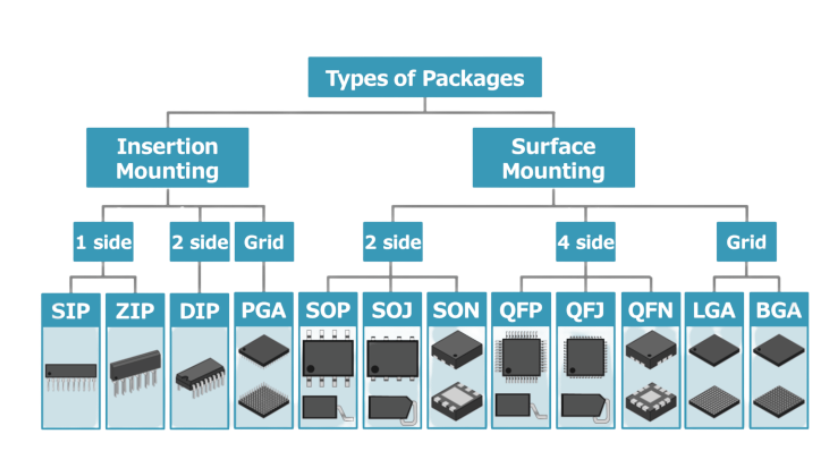In modern society, electronic products are everywhere and have integrated into every aspect of our lives. Although various electronic devices have different functions, they all rely on integrated circuits. An integrated circuit is a microelectronic device that integrates multiple components and wiring on a semiconductor wafer. After packaging, it forms a functional structure, promoting the development of electronic components towards miniaturization and more.
What is an Integrated Circuit (IC)?
An integrated circuit (IC for short), also known as an integrated circuit, refers to the integration of multiple electronic components (such as diodes, transistors, resistors, etc.) onto a single chip to form a complete circuit system. The emergence of integrated circuits has made the design and manufacture of circuits more convenient and efficient. At the same time, it has greatly reduced the cost of circuits and promoted the development of modern electronic technology.
What Do Integrated Circuits (IC) Do?
An integrated circuit (IC) is a technology that integrates a large number of electronic components onto a small semiconductor chip. Lithography technology is used, and ultraviolet light is used to print components onto a substrate simultaneously. This is more efficient, lower in cost, and more reliable in performance than discrete components.
ICs have significant advantages:
Function integration makes circuit design flexible and compact.
Facilitates design and manufacturing, helping with the rapid development of electronic products.
Reduces volume, making products lightweight and portable.
Lowers costs and enhances price competitiveness.
Improves performance and speeds up data transmission and processing.
Enhances reliability and reduces failure rates.
Evolution of IC Manufacturing
The development history of integrated circuits (ICs, Integrated Circuits) is a crucial chapter in the history of modern electronic technology. It not only accelerates the miniaturization of electronic products but also provides impetus for innovation in many industries.
Initial Stage (Late 1950s - Early 1960s): Before this, electronic devices relied on bulky vacuum tubes. The invention of the transistor in 1947 made miniaturization possible. Although transistors were widely used, multiple individual components were still required. In 1958, Jack Kilby from Texas Instruments in the United States invented the first integrated circuit, integrating multiple electronic components such as transistors, resistors, and capacitors on a small chip. This marked a major revolution in electronic technology, making devices more compact and efficient.
Commercialization and Development (The mid-1960s - Early 1970s): In 1961, the first commercial integrated circuit was introduced. Subsequently, Intel also launched its integrated circuit products, promoting the widespread application of the technology. In 1965, Gordon Moore, the founder of Intel, proposed "Moore's Law", which states that the number of transistors on an integrated circuit doubles approximately every 18 months, becoming a guiding principle for the development of integrated circuits and microprocessors.
Birth and Popularization of Microprocessors (The mid-1970s - Early 1980s): In 1971, Intel launched the first microprocessor, the 4004 processor, which was the first integrated circuit to integrate the computer's central processing unit (CPU) onto a single chip, laying the foundation for the miniaturization and popularization of computers. In the late 1970s, with the maturity of microprocessor technology, personal computers (PCs) began to emerge, and integrated circuits gradually entered people's daily lives, strongly promoting the arrival of the information-based society.
Technological Leap (1990s - Early 2000s): With the continuous progress of semiconductor technology, the manufacturing process of integrated circuits has become increasingly refined, evolving from the micron level to the nanometer level. This enables a single chip to integrate more functions and significantly improves performance. In the 1990s, with the rapid development of mobile communication and consumer electronics, integrated circuits gradually evolved towards system-on-a-chip (SoC), integrating more functions into a single chip and being widely used in devices such as smartphones and tablets.
Current Situation (Since the 2010s): The manufacturing process of integrated circuits has entered the nanometer-level stage such as 7nm and 5nm. The performance and efficiency of integrated circuits are constantly improving, with chips becoming faster and having lower power consumption. New - generation microprocessors, GPUs (Graphics Processing Units), etc. are widely used in cutting-edge fields such as artificial intelligence, big data, cloud computing, and autonomous driving. In the future, integrated circuits will continue to play a key role in fields such as quantum computing, deep learning, and 5G communication, driving the continuous development of technology. Starting from the simple integration of transistors, to today's high-performance and miniaturized chips, the development of integrated circuits has greatly promoted the popularization of electronic devices and technological innovation. From early computers to today's smartphones, autonomous vehicles, etc., integrated circuits are everywhere and have become the cornerstone of modern technology.
Types of Integrated Circuits
Integrated circuits (ICs) can be classified from multiple perspectives, including scale, function, application, and technology. Here are some common classification methods for integrated circuits:
Classification by Function
Digital Integrated Circuits: Process discrete digital signals, such as microprocessors, memories, and logic gate arrays.
Analog Integrated Circuits: Process continuous analog signals, such as operational amplifiers, audio amplifiers, and analog switches.
Mixed - Signal Integrated Circuits: Process both digital and analog signals simultaneously, such as analog-to-digital converters (ADCs) and digital-to-analog converters (DACs).
Power Integrated Circuits: Used to control and drive high-current loads, such as power management chips and motor drivers.
Classification by Application
General-Purpose Integrated Circuits: Standard circuits with a wide range of uses, such as general-purpose logic gates, counters, and registers.
Application-Specific Integrated Circuits (ASICs): Circuits designed for specific applications, such as image processors and communication chips.
System-on-a-Chip (SoC): Circuits that integrate the functions of a complete electronic system, including processors, memory, and peripherals.
Radio-Frequency Integrated Circuits (RFICs): High-frequency circuits for wireless communication, such as RF transceivers and frequency synthesizers.
Classification by Technology
Bipolar Integrated Circuits: Use bipolar transistors, characterized by high speed but relatively high power consumption.
Metal - Oxide - Semiconductor (MOS) Integrated Circuits: Use MOS transistors, characterized by low power consumption and high integration.
Complementary Metal - Oxide - Semiconductor (CMOS) Integrated Circuits: Combine n-type and p-type MOS transistors and are the most commonly used integrated circuit technology currently.
Bipolar CMOS (BiCMOS) Integrated Circuits: Combine bipolar and CMOS technologies, having the advantages of both speed and low power consumption. These classification methods can be combined to more accurately describe the types and characteristics of integrated circuits.

IC Packaging Types
The packaging method of an IC chip refers to encapsulating the chip into a pin-equipped housing for easy connection to a circuit board. Different packaging methods are suitable for different application scenarios and cost requirements. Common IC packaging types are as follows:
Through - Hole Packaging
Dual In-line Package (DIP): Pins are led out from both sides of the package in a straight-row arrangement and inserted into the circuit board through pins. It has a simple structure and low cost and is suitable for manual soldering, but it has a large volume, a limited number of pins, and poor anti-interference performance.
Pin Grid Array (PGA): There are multiple square-array pins inside and outside the chip, arranged at intervals around the chip, which can be arranged in 2 - 5 circles. It is convenient for plug-and-play operations, has high reliability, and can adapt to higher frequencies, but it will affect the wiring of multi-layer PCBs.
Surface - Mount PackagingSmall-Outline Package (SOP): Pins are led out from both sides, and it is a flat package that can be directly soldered onto the PCB. It is suitable for SMT installation and wiring, with reduced parasitic parameters and high reliability in high-frequency applications.
Quad Flat Package (QFP): Pins are led out from four sides and are horizontal straight lines with small inductance, and can operate at higher frequencies. It has a small volume, dense pins, and good anti-interference performance, and is suitable for high-density circuit applications.
Plastic Leaded Chip Carrier (PLCC): A plastic-packaged chip carrier with J - shaped pins. It uses a chip-carrier package, which is convenient for replacing integrated circuits in the system.
Leadless Ceramic Chip Carrier (LCC): Pins are embedded on the four sides of the ceramic package and conduct through contact, and it is sometimes also called CLCC. If the carrier structure and pin shape are slightly modified, it can be directly soldered to the PCB without the need for a socket.
Other PackagingBall Grid Array (BGA): Connects the chip and the circuit board through ball-shaped solder balls, with high pin density, good vibration resistance, and excellent thermal conductivity. It is suitable for high-speed and high-density applications, such as CPUs and GPUs.
Chip-Scale Package (CSP): The chip is directly packaged on a small substrate with almost no external pins. It is very small and lightweight and is suitable for applications that require minimization, such as handheld devices and embedded systems.
Quad Flat No - lead (QFN): The four sides of the package are configured with electrode contacts. Since there are no pins, the mounting area is smaller than that of QFP, and the height is lower than that of QFP. It has the characteristics of small size, good heat dissipation, and good electrical performance, and is suitable for high-speed and high-frequency ICs.
What is PCB and IC?
An integrated circuit generally refers to the integration of a chip. Components like the north-bridge chip on a motherboard and the inside of a CPU are all called integrated circuits, and the original name was also "integrated block". A PCB, on the other hand, refers to the circuit board we commonly see, and it is also used for printing and soldering chips on the board. Understanding the relationship between the two: An integrated circuit (IC) is soldered onto a PCB; the PCB is the carrier of the integrated circuit (IC). Simply put, an integrated circuit integrates a general-purpose circuit onto a chip. It is a whole, and once it is damaged internally, the chip is also damaged. A PCB, however, allows for the self-soldering of components, and if a component is damaged, it can be replaced.
Hot-selling products of SIC
MAX1093BCEG+ MAX1396ETB+T DS1809U-100/T&R MAX167CENG AD7788ARM-REEL
MAX162CCWG+ AD5254BRU1 AD1674JRZ LTC2635CMSE-LMI8#PBF PCM1748KE
Product information is from SIC Electronics Limited. If you are interested in the product or require product parameters, you can contact us online at any time or send us an email: sales@sic-components.com.









 Wishlist (0 Items)
Wishlist (0 Items) 